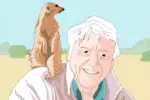As the end of summer approaches, I find myself feeling lost in time. Mainly by thinking it’s still early June when it is in fact mid-August. As the pandemic continues to solidify its place within the world, it maintains its hold on the ability to physically be with one another. Within the wake of a pandemic lies a summer full of loss and pain, something that is subsequently explored by artists across all mediums.
In particular, rapper Jaden Smith approached his own artistic processing of the pandemic by releasing the single “Cabin Fever,” a bright and tender reflection of missing someone during a period of isolation. “Cabin Fever” is indicative of the way in which the pandemic is being experienced and explored through the production of music.
The spring of this year brought the release of upbeat music that ordinarily, would effortlessly solidify a soundtrack for the summer. Meg Thee Stallion released her third EP, “SUGA,” on March 6, featuring self-empowered and resilient tracks such as “Savage” and “B.I.T.C.H.” that promised an aura of carefree summertime confidence.
Similarly, Dua Lipa released her second studio album, “Future Nostalgia,” on March 27, coinciding perfectly with the start of quarantine. “Future Nostalgia” was a sentimental blend of disco and pop that begged for physical interactions — an album that was subsequently enjoyed from the privacy of our own homes. At the start of quarantine, a typical summer seemed well in reach. Now nearly six months later, after this summer has solidified itself as an anomaly, it is clear that the pandemic is here to stay.
With that collective and albeit stubborn realization comes a slow change in artistic content. The music industry in particular has already had to reckon with aspects of the pandemic, regardless of the music’s overarching theme. Whether it be through the influx of music and videos that are produced from home or spending hundreds of thousands of dollars on coronavirus tests, the music industry has had to recalibrate.
Music, regardless of genre, naturally lends itself to introspection, and projects created during a pandemic feel increasingly more sanguine. Similarly, “Cabin Fever” signals the inevitability of the changing reality of romance and social interactions as a whole during a pandemic. Smith has stated that “Cabin Fever” was his “version of a quarantine love song,” thereby reflecting on the impact the pandemic has on the content of music overall.
The video for “Cabin Fever” begins with Smith alone on a beach. As he drives through a technicolored Malibu, the video is filled with chromatic hues of pink and blue, a familiar motif in Smith’s sunset-driven aesthetic. This speaks to Smith’s overall artistic lens, but also how his vision and brand have had to transform throughout this specific time period. The video shifts to a shot of Smith sitting alone in his room with a mask on. Behind him are posters with “Black Lives Matter” and “No Justice, No Peace” written on them.
The video continues with Smith daydreaming about his love interest, balancing vibrant summertime cliches alongside the emotional impact of quarantine. Smith sings, “Dreaming ‘bout it, summertime / Thinking ‘bout it, summertime / Tall palm trees and kaleidoscope dreams / I’m at home thinking ‘bout you and me.” The love interest in the video is unable to hang out with Smith, presumably because of social distancing. Smith holds up a sign in front of her house, asking her to hang out. “I can’t,” she writes back. Although the separation between Smith and his romantic interest throughout the song may hit close to home, the song’s upbeat and melodic rhythm strengthen the single, allowing it to also be considered a breezy, feel-good song.
The single sparks the release of Smith’s upcoming album, “CTV3,” set to release on Aug. 28. Smith’s artistic vision has previously coincided with the aesthetic of summer, as his previous project, “ERYS,” came out in July of 2019 and encapsulated the season perfectly. In particular, the single “Summertime in Paris” was a dreamy love song that lounged in the allure of romantic imagination. But at that point in time, exploring romantic relationships was much more attainable than it would be this year under pandemic guidelines, even as some places across the country begin to reopen.
This shift has led to a society caught in turbulence, impacting all facets of our lives. Quarantine called for indefinite lengths of isolation, something that presents an obvious strain on romantic relationships in particular. This is something that is explored by Smith within “Cabin Fever” as he navigates the perplexing ache of isolation and relationships.
“Cabin Fever” confronts the way in which the pandemic has caused apparent rifts within the culture of dating, specifically among young adults and teenagers. In an article published by The New York Times, the Learning Network asked high school students to share how the pandemic has infiltrated their relationship with dating. Most pointed out similar things, particularly how the separation caused by social distancing both confuses and intensifies the future of the relationship.
Some teenagers noted how issues with mental health were exasperated during quarantine, and the way that the muddled communication brought on by social distancing has further strained romantic relationships. Some said their relationships may have lasted longer if it wasn’t for the quarantine.
“Cabin Fever” toys with this issue both lyrically and visually. In its entirety, the single grapples with the changing position of romance in our culture in response to the pandemic. As Smith muses over someone he cannot physically be with, despite his longing to, he presents the new reality that we are all coping with. Smith understands the way that things are, but manages to relish in the idea of possibility. As each day brings another news cycle regarding the current state of the pandemic, “Cabin Fever” is a small reminder of the capability of love in times of physical distance.

















I loved reading this post about Jaden Smith’s ‘Cabin Fever’! The way he captures the essence of love in such a chaotic world is truly inspiring. It’s amazing how his music reflects personal growth and the challenges we all face. Can’t wait to hear more from him!
I really appreciated how Jaden Smith captures the essence of love and resilience in ‘Cabin Fever.’ It’s such a relatable expression of navigating through life’s uncertainties. His ability to intertwine personal experiences with broader themes is truly moving. Can’t wait to see more of his work!
I loved this post! Jaden’s ability to blend his personal experiences with broader themes of love and change really resonates. ‘Cabin Fever’ captures that feeling of uncertainty so well, yet offers a hopeful perspective. It’s a refreshing take on navigating our complex realities. Thanks for sharing your insights!
Jaden’s exploration of love in ‘Cabin Fever’ amidst such transformative times is truly captivating. It’s refreshing to see how he blends personal experiences with broader societal themes. This album feels like a journey of introspection and connection, and I appreciate how it resonates with so many of us navigating change. Can’t wait to dive deeper into the lyrics!